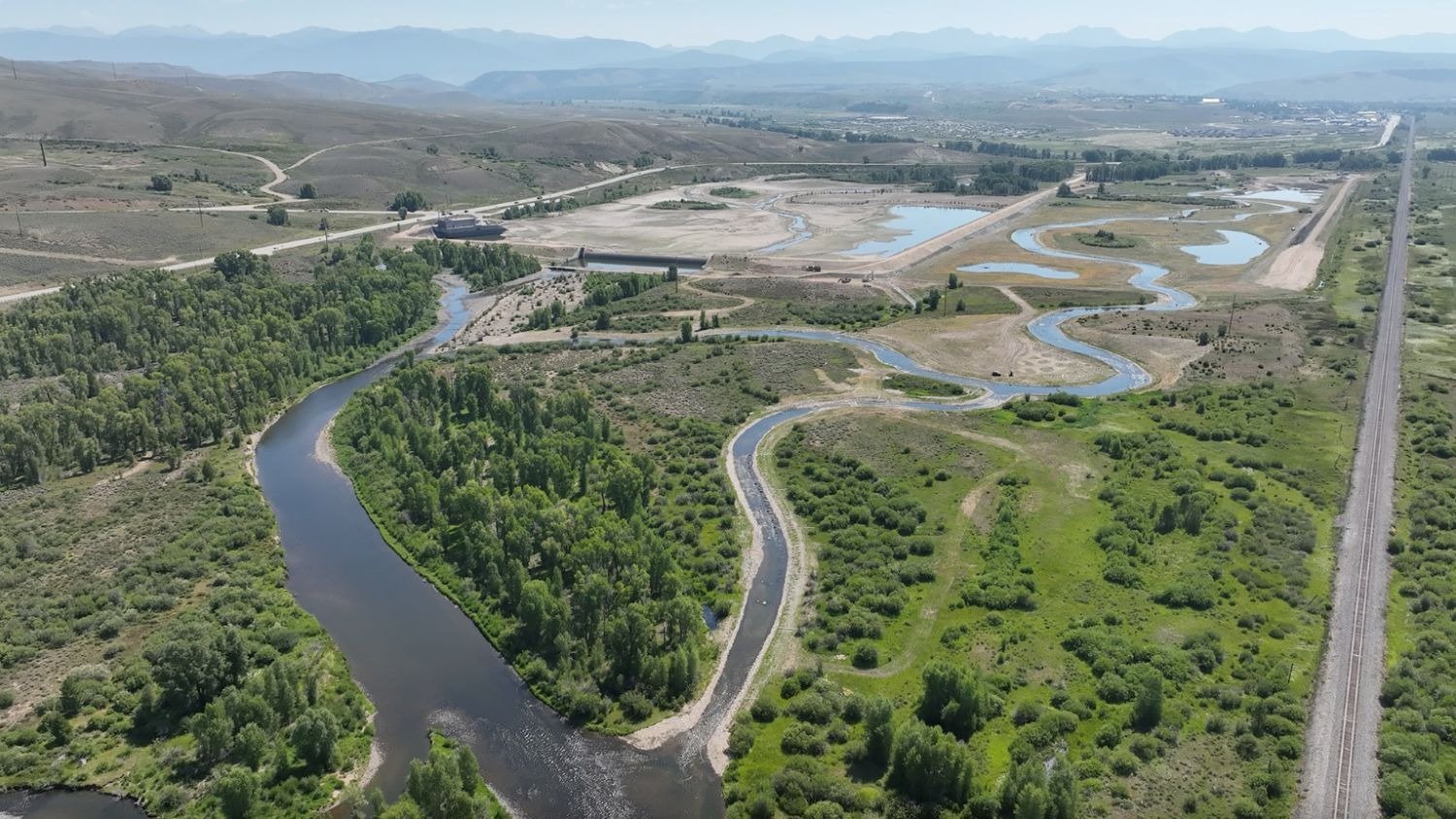At 45, Fry-Ark not so golden
Drew Peternell, director of the Trout Unlimited Colorado Water Project, called for a programmatic environmental impact statement on the Fry-Ark Project to look at how it has changed over the years.
http://www.chieftain.com/metro/1180771084/1
Concerns for the future of the project are weighed down by the need for water for growth.
By CHRIS WOODKA THE PUEBLO CHIEFTAIN
A congressional hearing Friday began with a film of President John F. Kennedy at Dutch Clark Stadium on a hot August day in 1962, heralding the cooperative spirit of the Fryingpan-Arkansas Project.
The hearing ended in a less cooperative spirit after a morning that proved the testimony of one witness who said Colorado water is a geographic, rather than political concern.
“To make life better for some of the people is to make life better for all of the people,” Kennedy said, outlining the benefits of the project for the farms and cities of the Arkansas Valley in his riveting speech.
The words drew applause from a crowd 45 years later as a field hearing of the water and power subcommittee of the House Natural Resources Committee opened at Pueblo Community College.
“This is our future,” said committee chairwoman Rep. Grace Napolitano, D-Calif. “It was just as evident and true then as it is today.”
Napolitano said the hearing in Pueblo is the second she has held - the first was last year in Pomona, Calif. - to assess the water needs of Western states. About 150 people attended the 3-hour event.
People from Leadville, the Lower Arkansas Valley, Colorado Springs, Aurora and Pueblo came to hear public statements on rating the success of the Fry-Ark Project.
The hearing took on shades of partisanship, more from a geographic standpoint than by political parties, as described by Wally Stealey, former president of the Southeastern Colorado Water Conservancy District, who told the committee water is a geographic issue.
Rep. John Salazar, D-Colo., promoted his version of a Fryingpan-Arkansas bill through his statements and questions of witnesses throughout the hearing, making no bones about his defense of agriculture and small communities.
“I believe it is immoral for large cities to rob small towns for the sake of growth,” said Salazar, who represents Pueblo, the San Luis Valley and the Western Slope. “To add insult to injury, the Bureau of Reclamation has not made the case that it can contract with entities outside the basin.”
Holding a golden frying pan, he told the story of John Singletary, chairman of the Lower Arkansas Valley Water Conservancy District, who helped his parents sell the pans to promote the project in the 1950s.
“John Singletary didn’t help his parents sell golden frying pans so the water could be sold out of the Arkansas Valley,” Salazar said.
Meanwhile, Rep. Doug Lamborn, the lone Republican on the committee, was equally vigorous in promoting the interests of Colorado Springs, which he represents. He is sponsoring competing legislation that adheres to past intergovernmental agreements for the Preferred Storage Options Plan.
At one point Lamborn labeled the negotiations over PSOP as being stalled by “a few obstructionists” and promoted the view that the Fry-Ark Project should focus on future growth.
“The old adage of build it and they will come no longer applies to Colorado. They’ll come anyway,” Lamborn said.
Rep. Ed Perlmutter, Salazar’s Democratic colleague, disagreed with Salazar’s view that the Fry-Ark Project originally was intended primarily to benefit agriculture. Perlmutter, who represents Aurora and other growing areas in the Denver suburbs, focused on Kennedy’s statement that Fry-Ark was an “investment in the growth of the West.”
“I believe there is a real opportunity to find a compromise. I would love to see a solution,” Perlmutter said.
Finally, Democratic Senate Candidate Mark Udall gave a nod to Western Slope interests in the Fry-Ark Project, but generally took the high road in his comments and questions.
“Nothing is more important to us in the West - it is our lifeblood - than water,” Udall said.
Testimony followed lines of self-interest as well, as most of the 11 witnesses struggled to conform to guidelines that allowed only five minutes of testimony.
Jay Winner, general manager of the Lower Ark district, drew spontaneous applause for his testimony lamenting the decline of agriculture and the increasing burden of small communities in dealing with water quality as the Fry-Ark Project has aged.
Colorado Springs has worked for its own benefit, rather than with Fry-Ark partners and Aurora has “bullied its way into the valley,” Winner said.
The exchanges of the cities have hurt water quality, he said.
“When we talk about water quality, here’s a good example of what has happened,” Winner said, holding up jars of muddy water from the Lower Arkansas Valley and clean water from mountain lakes. “They bought this (the dirty) water and took this (the clean water). . . . I’m told over and over (by the cities) it’s too expensive to clean up the water, so the burden falls on the Lower Arkansas Valley.”
Mayors Lionel Rivera of Colorado Springs and Ed Tauer of Aurora urged the congressional delegation to look to the future and needs of growth, rather than dwelling on the past. Both emphasized their significant financial contribution to repayment of the project - Colorado Springs through taxes, Aurora through contracts.
“For all the rhetoric and misinformation that has been spread about our city, the truth is that Colorado Springs has historically sought to avoid relying on the transfer of agricultural water rights to provide a water supply for the city,” Rivera said.
Napolitano took Rivera to task, asking why the city has not dedicated more effort to reusing its supply.
Rivera responded that the city reuses 13 percent of its water supply for public landscapes and power plants and touted the city’s conservation efforts, sewage and stormwater control.
Tauer described the Fry-Ark Project as a “series of pipes, pumps and buckets that allow people to move water and defended Aurora’s right to contract with Reclamation for excess-capacity space. He praised intergovernmental agreements Aurora has made in the valley to attempt to address ill effects of water transfers.
“Aurora will continue to cooperate with all involved entities to promote the Bureau’s goals of maximum utilization of existing infrastructure,” Tauer said.
Napolitano asked Tauer if Aurora isn’t creating a situation in the Arkansas basin similar to the Owens Valley in California, which was dried up by Los Angeles. Tauer said the IGAs prevent Aurora from taking more water from the valley.
Bill Long, president of the Southeastern District, said the construction of the Arkansas Valley Conduit is the most important piece of the Fry-Ark Project that has yet to be developed.
The conduit was part of the 1962 legislation, but never built because communities could never afford it.
“If we don’t get the conduit, the project will ultimately be used to move water out of the valley,” Long said.
Terry Scanga, executive director of the Upper Arkansas Valley Water Conservancy District, said the project has changed over the years, providing water for the growth of a recreation industry and new growth in the upper end of the river.
Pueblo District Attorney Bill Thiebaut said the major new challenge of the project is water quality.
“The quality can change as fast as the use,” Thiebaut said.
Drew Peternell, director of the Trout Unlimited Colorado Water Project, called for a programmatic environmental impact statement on the Fry-Ark Project to look at how it has changed over the years.
Chris Treese, manager of external affairs for the Colorado River Conservation District, said the original Fry-Ark Project was intended to market water to an oil shale industry that has not materialized. He asked Congress to look at the repayment plan for Ruedi Reservoir to avoid higher lease rates in the future as interest piles up.
Sandy White, a lawyer representing The Pueblo Chieftain and other valley water interests, challenged Reclamation’s authority to enter contracts with Aurora, saying Aurora circumvents state law with federal contracts.
“The Bureau essentially is on an adventure of its own,” White said.
Mike Ryan, Great Plains regional director for the Bureau of Reclamation, defended contract policies, saying the Fry-Ark Project is not harmed by the bureau’s actions.
Stealey, however, disagreed.
“The biggest danger we’ve got is diminishing the taxpayers’ role in the Fry-Ark Project by diluting the stock,” Stealey said. “When does it quit becoming the Bureau of Urban Development? Some of us are very angry.”







